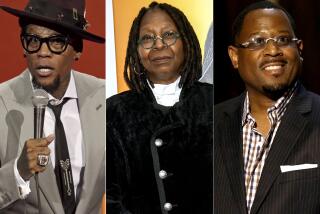Vote on Chavis Ouster to Affect NAACP Policy
- Share via
WASHINGTON — The climactic vote by the NAACP board of directors scheduled Saturday on whether to oust Executive Director Benjamin F. Chavis Jr. would appear to center on a scandal: Did he sexually discriminate by firing an NAACP employee, and did he improperly use the civil rights organization’s funds to buy her off?
But as serious as those charges are, the vote will mean much more. Whatever the 64-member board decides--to clear Chavis, to censure him or to fire him--it will be choosing the route the NAACP will take in its attempt to once again become the predominant voice of black America’s political and social aspirations.
Many of those who are pressing to remove Chavis also want to turn away from his policies of revitalizing the organization through alignment with more militant activists, including Nation of Islam minister Louis Farrakhan. Older, more established members prefer to hew to the organization’s traditional methods of fighting racial segregation and discrimination.
The charges against him notwithstanding, Chavis’ allies see him as the organization’s best hope of regaining relevance to young people in the post-civil rights era.
His foes gained the upper hand a month ago when it was revealed that Chavis had agreed to pay up to $332,400 to Mary E. Stansel, a former aide who had accused him of sexual discrimination and harassment. He did so without consulting the board or the NAACP’s general counsel. Stansel has since sued the NAACP, alleging that Chavis did not keep his promise.
Last weekend, the group’s West Virginia branches issued a resolution calling for his resignation and that of board Chairman William F. Gibson, who has been Chavis’ most ardent supporter. Support also dramatically eroded among board members from the South, who almost always vote in a block. And for his part, Gibson is signaling that he wants to distance himself from Chavis.
But in recent days Chavis has mounted a vigorous counterattack. On Tuesday night, he attended a rally in a black New York church attended by many youthful supporters, and again denied the charges. “There is a systematic campaign of character assassination being directed at me and the NAACP,” he said.
On Wednesday, more than 50 Southern grass-roots human rights organizations attended an Atlanta news conference to announce their support for Chavis.
With her voice breaking and tears rolling down her cheeks, Angela Brown of Kitrell, N.C., a representative of the Southwide Youth Task Force, pleaded for Chavis to remain at the helm of the NAACP. “I appeal to the NAACP board, as a young person, to do the right thing for the sake of my generation and all the generations to come after me.”
Under the leadership of Roy Wilkins, the NAACP membership began to sag, especially among younger black Americans. The ranks dropped dramatically from a high of about 500,000 members in the mid-1960s.
Benjamin L. Hooks, whose resignation last year led to Chavis’ appointment, was able to regain some lost ground, but he was never able to return the organization to the strength it achieved in the waning days of the civil rights movement.
“When I was growing up, the NAACP was like that Oldsmobile commercial,” said Bowyer G. Freeman, a white-collar professional in his 30s in suburban Washington. “The NAACP was perceived by folks my age as an organization your parents belonged to, not us.”
When Chavis assumed the executive director’s job in April, 1993, he pledged to revitalize the organization by attracting new and younger members with an aggressive, confrontational approach. By his count he signed up about 100,000 new members, swelling the organization to an estimated 600,000 members. Most of those, he said, were young people who had never before belonged to the NAACP.
In the process, Chavis, who is 49, grated against the group’s older members. His embrace of Los Angeles gang members in the aftermath of the riots in Los Angeles, his private meeting with black nationalists in Detroit and his invitation to Farrakhan to join mainstream black leaders at a summit last June at the NAACP headquarters raised eyebrows among more conservative NAACP members.
Farrakhan, in fact, has proved to be a wedge issue for Chavis. Although the black nationalist leader is widely condemned as anti-white and anti-Semitic by some white and black leaders alike, he boasts an enormously enthusiastic following among young, radical and activist black Americans.
Chavis and Farrakhan are soul mates in their shared strategy of building grass-roots movements among neglected and angry black American youths. During his early days as a street activist, Chavis was sentenced--unjustly, it turned out--to four years in jail for the firebombing of a white-owned grocery store in Wilmington, N.C. As the most famous member of the Wilmington 10, Chavis used his prison experience to study religion and hone his approach to civil rights activism.
In an interview shortly after he took over the NAACP, Chavis said he was certain young people would embrace him as they did Malcolm X and later Farrakhan--both icons of black defiance who built movements with direct appeals to prison inmates--because each of them understood how racism and oppression crippled black people. The NAACP needed a similar strategy, Chavis said in that interview.
“We must become organizers of the poor and rejected, because only when we build a mass-based movement in this country will we really convince those in power to stop their policies,” Chavis said a year ago.
Some black Americans, like Manning Marable, director for the Institute for Research in African American Studies and professor of history at Columbia University, find Chavis “a visionary” who looked past the NAACP’s history “to understand there is a sense of broader black national interests that has been overlooked” by other black leaders.
But for many who had grown up within the NAACP, Chavis’ approach was offensive, almost a stick-it-to-you arrogance. Their NAACP favored the kinds of strategies--lengthy and detailed legal challenges, political activism and quiet behind-the-scenes negotiations--that had empowered the organization to challenge discriminatory laws in the 1940s, desegregate public schools in the 1950s and secure voting rights in the 1960s.
Others from outside the organization also wrinkled their brows. Chavis couldn’t pursue his strategy to boost the NAACP and keep old-line supporters--organized labor groups, Jewish organizations and private philanthropies--content with his leadership if he continued to embrace Farrakhan.
“We can’t tell the NAACP who to invite to their meeting; that’s their right,” said Richard Womack, director of the civil rights department of the AFL-CIO in Washington. “But we could tell them we wouldn’t participate after we learned who would be attending. That is our right.”
Some, such as NAACP board member Joe Madison, a Washington radio talk show host, feared that financial ruin was imminent. “Chavis doesn’t understand that he risks the financial base of the NAACP by cozying up with radicals and nationalists,” said Madison, who sits on the board’s finance committee.
Money is another of the NAACP’s problems.
The NAACP operates from an estimated $7-million annual budget and is more than $3 million in debt. The fount of that debt is yet another point of internal squabbling. Chavis has said he inherited a $2.7-million debt from his predecessor.
Hooks angrily responded in several published reports that he left the organization with a $600,000 surplus when Chavis took over last year. “It’s not a matter of Chavis versus Hooks,” he is quoted in Newsweek magazine. “It’s Chavis versus the books.”
Outsider funders, like the Ford Foundation, have taken notice. The first half of an approved two-year, $500,000 grant hasn’t been disbursed, pending discussions with NAACP officials over the group’s financial practices. Lloyd Garrison, a foundation spokesman, said the $250,000 grant wasn’t withdrawn. “We’re having further discussions with the NAACP, and once those discussions are finished a decision will be made on the disbursement,” he said.
Some NAACP members have cited Chavis’ free-spending ways as executive director as reason enough to ask for his resignation. An unsigned memo is circulating from fax machine to fax machine among board members, demanding “all books and accounts be audited by outside independent auditors, including the government agencies that regulate not-for-profit agencies.”
If Chavis is removed, a source close to the board said, possible interim replacements are Earl Shinholster, a longtime NAACP official with strong ties to the traditional elements within the group, or A. Leon Higgenbotham, a retired federal appeals judge.
Regardless who is tapped to fill a temporary vacancy at the top, if it becomes necessary, the practical impact of the Chavis controversy has been to expose deep fissures in the NAACP--and, by extension, the remnants of the 1960s civil rights movement--that remain to be repaired. And the most important question will remain: What direction will the NAACP take in the post-civil rights era.
Researcher Edith Stanley contributed to this story from Atlanta.
More to Read
Sign up for Essential California
The most important California stories and recommendations in your inbox every morning.
You may occasionally receive promotional content from the Los Angeles Times.










